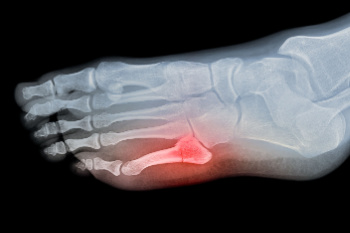Items filtered by date: October 2024
Is Laser Treatment Effective for Toenail Fungus?

Toenail fungus, or onychomycosis, is a common condition that can be difficult to treat. Traditional conservative treatments, such as antifungal medications and topical solutions, often require lengthy durations and may not deliver satisfactory results. In contrast, toenail laser treatment offers a promising alternative. This innovative approach utilizes focused light to target and eliminate fungal organisms without damaging surrounding tissue. Clinical studies indicate that laser treatment can significantly reduce fungal presence and promote healthy nail regrowth more effectively than more conservative methods. Additionally, laser treatment typically involves fewer side effects and a shorter recovery time. While results may vary depending on the severity of the infection, many patients report improvement after just one or two sessions. For those struggling with persistent toenail fungus, laser treatment presents a compelling option to consider for achieving lasting results. If you have developed this unsightly condition, it is suggested that you consult a podiatrist who can determine if laser treatment is right for you.
Laser treatment can be an effective way to get rid of toenail fungus. If you have any questions about laser treatment, consult with one of our podiatrists from Centers for Foot & Ankle Care. Our doctors will assess your condition and provide you with quality treatment for fungal nails.
What Are Toenail Fungal Infections?
Onychomycosis, or fungal infection of the nail, is a relatively common and non-serious condition. Around 10 percent of U.S. citizens are afflicted with fungal nails. Common forms of fungus that infect the nail include dermatophytes, yeasts, and molds.
Symptoms of Toenail Fungal Infections Include:
- Nail thickening
- Brittleness of the nail
- Discoloration of the nail
Diagnosis for Fungal Nails
Fungal infections are diagnosed by fungal culture and microscopy. This will rule out any other conditions such as nail trauma, psoriasis, lichen planus, and onychogryphosis.
What Is Laser Treatment?
Laser treatment is a non-invasive, safe, quick, and painless procedure that uses the heat from a laser to kill fungus in the nail. Each infected nail is targeted with a laser for several minutes. The treatment is usually utilized several different times over a select period. During this time, a podiatrist will keep an eye on the infection.
If you have any questions, please feel free to contact one of our offices located in Merrillville, Portage, Michigan City/LaPorte, and Schererville, IN . We offer the newest diagnostic and treatment technologies for all your foot care needs.
How Foot Stress Fractures are Diagnosed

A foot stress fracture is a small, hairline crack in a bone resulting from repetitive stress or overuse, commonly occurring in athletes and active individuals. Symptoms typically include localized pain that intensifies with activity, tenderness when pressure is applied, and swelling around the affected area. Causes often involve increased physical activity, improper footwear, or sudden changes in exercise routines. Conditions like osteoporosis can also contribute to the risk of stress fractures. Diagnosing a foot stress fracture usually begins with a thorough physical examination by a podiatrist who will assess pain levels and check for tenderness. Imaging tests, such as X-rays or MRI scans, may be necessary to confirm the diagnosis and rule out other injuries. Early detection is vital for effective treatment and recovery, allowing individuals to return to their activities safely. If you have sustained a foot stress fracture, contact a podiatrist for treatment.
Stress fractures occur when there is a tiny crack within a bone. To learn more, contact one of our podiatrists from Centers for Foot & Ankle Care. Our doctors can provide the care you need to keep you pain free and on your feet.
How Are They Caused?
Stress fractures are the result of repetitive force being placed on the bone. Since the lower leg and feet often carry most of the body’s weight, stress fractures are likely to occur in these areas. If you rush into a new exercise, you are more likely to develop a stress fracture since you are starting too much, too soon. Pain resulting from stress fractures may go unnoticed at first, however it may start to worsen over time.
Risk Factors
- Gender – They are more commonly found in women compared to men.
- Foot Problems – People with unusual arches in their feet are more likely to develop stress fractures.
- Certain Sports – Dancers, gymnasts, tennis players, runners, and basketball players are more likely to develop stress fractures.
- Lack of Nutrients – A lack of vitamin D and calcium may weaken the bones and make you more prone to stress fractures
- Weak Bones – Osteoporosis can weaken the bones therefore resulting in stress fractures
Stress fractures do not always heal properly, so it is important that you seek help from a podiatrist if you suspect you may have one. Ignoring your stress fracture may cause it to worsen, and you may develop chronic pain as well as additional fractures.
If you have any questions, please feel free to contact one of our offices located in Merrillville, Portage, Michigan City/LaPorte, and Schererville, IN . We offer the newest diagnostic and treatment technologies for all your foot care needs.
Focus on Metatarsal Shaft Fractures

Diagnosing foot fractures, particularly metatarsal shaft fractures, involves a thorough evaluation by a podiatrist. These fractures commonly result from direct trauma, overuse, or sudden twisting movements. Symptoms patients typically experience include localized pain, swelling, bruising, and difficulty bearing weight on the affected foot. A physical examination is essential for assessing tenderness and deformity. Diagnostic imaging, primarily an X-ray, is used to confirm the fracture and determine its severity. In some cases, a CT scan or MRI may be recommended for a more detailed view of the injury. Timely and accurate diagnosis is essential for appropriate treatment, which may include rest, immobilization, or in severe cases, surgery. If you have broken your foot, it is suggested that you consult a podiatrist who can determine the type of fracture and offer appropriate treatment solutions.
A broken foot requires immediate medical attention and treatment. If you need your feet checked, contact one of our podiatrists from Centers for Foot & Ankle Care. Our doctors can provide the care you need to keep you pain-free and on your feet.
Broken Foot Causes, Symptoms, and Treatment
A broken foot is caused by one of the bones in the foot typically breaking when bended, crushed, or stretched beyond its natural capabilities. Usually the location of the fracture indicates how the break occurred, whether it was through an object, fall, or any other type of injury.
Common Symptoms of Broken Feet:
- Bruising
- Pain
- Redness
- Swelling
- Blue in color
- Numbness
- Cold
- Misshapen
- Cuts
- Deformities
Those that suspect they have a broken foot shoot seek urgent medical attention where a medical professional could diagnose the severity.
Treatment for broken bones varies depending on the cause, severity and location. Some will require the use of splints, casts or crutches while others could even involve surgery to repair the broken bones. Personal care includes the use of ice and keeping the foot stabilized and elevated.
If you have any questions please feel free to contact one of our offices located in Merrillville, Portage, Michigan City/LaPorte, and Schererville, IN . We offer the newest diagnostic and treatment technologies for all your foot and ankle needs.
Gout Pain Can Be Managed
Managing Eczema on the Feet

Eczema on the feet can cause discomfort and may appear in different forms. Included are atopic dermatitis, dyshidrotic eczema, neurodermatitis, and stasis dermatitis. Symptoms of eczema on the feet can range from itchy, dry, and inflamed skin to painful blisters or thickened, discolored patches. Factors such as genetics, stress, environmental triggers, and poor circulation can contribute to the development of eczema on the feet. Managing this condition requires proper care, including moisturizing to maintain the skin barrier, wearing appropriate footwear, and avoiding potential irritants. A podiatrist can help diagnose the specific type of eczema that affects your feet and recommend treatments. They may include topical medications or other therapies to reduce inflammation and prevent infection. If you have eczema on your feet, it is suggested that you schedule an appointment with a podiatrist for treatment.
Foot Pain
Foot pain can be extremely painful and debilitating. If you have a foot pain, consult with one of our podiatrists from Centers for Foot & Ankle Care. Our doctors will assess your condition and provide you with quality foot and ankle treatment.
Causes
Foot pain is a very broad condition that could be caused by one or more ailments. The most common include:
- Bunions
- Hammertoes
- Plantar Fasciitis
- Bone Spurs
- Corns
- Tarsal Tunnel Syndrome
- Ingrown Toenails
- Arthritis (such as Gout, Rheumatoid, and Osteoarthritis)
- Flat Feet
- Injury (from stress fractures, broken toe, foot, ankle, Achilles tendon ruptures, and sprains)
- And more
Diagnosis
To figure out the cause of foot pain, podiatrists utilize several different methods. This can range from simple visual inspections and sensation tests to X-rays and MRI scans. Prior medical history, family medical history, and any recent physical traumatic events will all be taken into consideration for a proper diagnosis.
Treatment
Treatment depends upon the cause of the foot pain. Whether it is resting, staying off the foot, or having surgery; podiatrists have a number of treatment options available for foot pain.
If you have any questions, please feel free to contact one of our offices located in Merrillville, Portage, Michigan City/LaPorte, and Schererville, IN . We offer the newest diagnostic and treatment technologies for all your foot care needs.
When Is Surgery Needed for Gout?

Gout is a form of arthritis that commonly affects the feet, particularly the big toe, and can often be controlled with medications and lifestyle changes. However, when gout progresses and causes significant joint damage or chronic pain, surgery may be necessary. Surgery for gout is typically considered when uric acid deposits, called tophi, form around the joints and lead to severe pain, deformities, or infections. The three main types of surgery are tophi removal, joint fusion, and joint replacement. Tophi removal involves cutting out the painful deposits while preserving healthy tissue. Joint fusion stabilizes the bones to relieve pain but may reduce mobility. Joint replacement, used in more advanced cases, involves putting in an artificial joint to improve function and reduce discomfort. A podiatrist can help determine the most appropriate gout treatment based on the severity of the condition. If you have chronic pain from gout, it is suggested that you schedule an appointment with a podiatrist wh can determine if surgery is needed.
Gout is a foot condition that requires certain treatment and care. If you are seeking treatment, contact one of our podiatrists from Centers for Foot & Ankle Care. Our doctors will treat your foot and ankle needs.
What Is Gout?
Gout is a type of arthritis caused by a buildup of uric acid in the bloodstream. It often develops in the foot, especially the big toe area, although it can manifest in other parts of the body as well. Gout can make walking and standing very painful and is especially common in diabetics and the obese.
People typically get gout because of a poor diet. Genetic predisposition is also a factor. The children of parents who have had gout frequently have a chance of developing it themselves.
Gout can easily be identified by redness and inflammation of the big toe and the surrounding areas of the foot. Other symptoms include extreme fatigue, joint pain, and running high fevers. Sometimes corticosteroid drugs can be prescribed to treat gout, but the best way to combat this disease is to get more exercise and eat a better diet.
If you have any questions please feel free to contact one of our offices located in Merrillville, Portage, Michigan City/LaPorte, and Schererville, IN . We offer the newest diagnostic and treatment technologies for all your foot and ankle needs.

